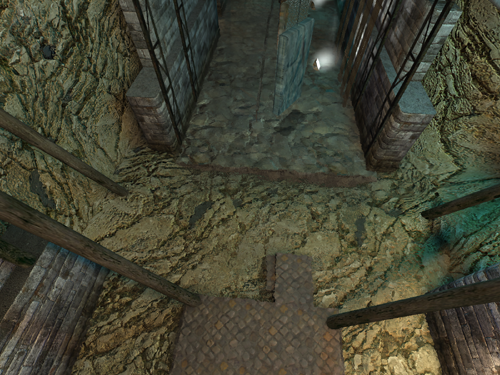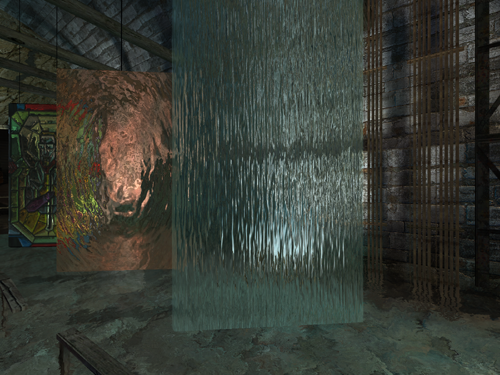Source Engine: Counterstrike Beta Hits The Street
by Derek Wilson on August 26, 2004 5:22 AM EST- Posted in
- GPUs
Source, CS, and Halflife 2
Before we take a look at the numbers, we have to know what we are dealing with. There are really three important components to address when looking at the beta version of Counterstrike: Source. First, there's the fact that the game is based on the Source engine and has a built in graphics stress test to push hardware to its limits and beyond. Next, there's Counterstrike and how that franchise fits into the equation. Finally, the crux of the matter, what do our observations reveal about the upcoming Halflife 2 title?
The opening of the Video Stress Test benchmark
In taking a look at the source engine test level supplied with CS:Source Beta, one of the first things we noticed was a difference in feeling between Source and id Software's latest engine. We've only got a test room and a sandy CS level to test the Source on, so we really haven't seen all that it has to offer, but our first impression of the engine is that it is very "clean". Clean like listening to an undistorted guitar after hearing some intensely heavy rock, or the feeling of looking at an HDTV next to an old UHF box. So far, the scenes we've seen rendered with Source show us that the engine is very good at producing crisp, clear images. Our initial impression of Doom III wasn't that it was any less real or vivid (we still got that warm, squishy, HD feeling inside), but that it was real in a dark, dirty, and atmospheric way. We will probably see how well Valve can coax their engine into producing similar situations at different points in Halflife 2, and surely there will be Doom III engine licensees who will create games with a slightly (for lack of a better word) happier feel. But at this point we don't have enough info to say that one engine is "better" than the other. So far, we'll just call them different. We are absolutely looking forward to seeing how Valve will integrate some of the very cool effects produced by the stress test in gaming situations.

Some of the more complex rendering that goes on in the Video Stress Test is overlapping reflective/refractive surfaces
Counterstrike: Source is somewhat of an interesting choice for Valve to lead off with. Historically, CS players have been very demanding on framerate. While we can't get 200fps at high resolutions, the subtle (and not so subtle) enhancements to the game engine add a depth to Counterstrike that could revitalize the franchise. Unlike the stress test, the enhancements in the one level available for play in Counterstrike: Source Beta (dust) aren't all about fire, water, reflection/refraction, and tv monitors. The main benefits we see in CS are in the added clarity, feeling of realism, and enhanced physics. Kicking a box or rolling an oil drum down a hill are fun enough to distract players from the game at hand. Actually, such real world interactions with the environment provide a new way to play: kicking a tire down one side of a hill to draw sniper fire, then running down the other is a very effective trick. Smoke and flashbang effects, muzzle flares, and explosions add to the experience as well. Lighting effects inside buildings pile on the realism. With the intensity of effects kept to a subtle level, high frame rates are still achievable, and if we decide to include CS: Source as a test game in future articles, we will put a larger emphasis on higher frame rates than we will from the stress test we will see benched here.
When it comes to Halflife 2, we still don't have a very good picture of how Counterstrike and the included stress test will relate to game play. We will very likely see less sheer graphical impact in the final version of HL2 than in the stress test. After all, Valve packed tons of water, translucent surfaces, and special effects into a tiny room in order to push graphics cards to the limit. We wouldn't expect (or want) to see a level like that in the game. Effects and eye candy are wonderful things, but game designers always need to be careful not to heap too much of a good thing on gamers. One of the most important aspects of the latest in the FPS genre is to put the player in the game as much as possible. At the same time, HL2 will have AI and huge levels with all kind of stuff going on. We really feel that HL2 will be much more CPU intensive than the graphics stress test (which we would hope), or even Counterstrike. Graphically, HL2 will likely be more intense than CS (as it will have more opportunity for strange alien special effects), though this remains to be seen.
So, with Halflife 2, we're looking at something more CPU intensive than both CS and the gpu stress test, and between the two in average graphical intensity. No, it's not easy to call. Especially since we haven't found a "good" way to benchmark our Counterstrike level yet. We take a brief look at CPU scaling with the video stress test on the A64FX platform, but this won't offer as much insight as we would like until we can get our hands on HL2. An in depth analysis of the impact of the cpu on the graphics engine as far removed from game play as possible could help us separate the graphics factor from the game benchmark later on if we decide to use HL2 as a CPU test (we are hoping to be able to test the impact of the new AI algorithm if possible).. Of course, that depends on the type of benchmarking software that comes with HL2 (if any).
But that's enough background. Now on to the tests.










50 Comments
View All Comments
DerekWilson - Thursday, August 26, 2004 - link
#18 If there are any typos, please point them out any typos and they will be corrected. We have already fixed the problem our first commenter pointed out.#19 We have Extreme cards from a couple different manufactures. We also have Platinum cards from a couple different manufactures. We wouldn't still be testing these cards if all we had were NV and ATI reference samples.
Drayvn - Thursday, August 26, 2004 - link
Umm, i dont know why, but there are no official Ultra Extremes only overclocked ones, nVidia has stated that they told the Add on manufacturers they can indeed overclock their cards, but they cannot call it the Ultra Extreme, so i dont know why u have that card in there as there are none, if u would have called it an Ultra OC then that would have been fine, because it seems there will never be an Ultra Extreme.esun - Thursday, August 26, 2004 - link
Regardless of the quality of the article and benchmarks and whatnot, it seems like there are a lot of typos in this article (just takes away from its credibility and professionalism IMO).DerekWilson - Thursday, August 26, 2004 - link
#15Sorry, the video stress test does not run with any sound. It actually does (as much as possible) what it says -- it focuses on video performance.
Jalf - Thursday, August 26, 2004 - link
Shame about the X800 pro. Would be interesting to be able to compare it to the GT at high-res. Would be interesting to see how much the GT benefits from having all 16 pipelines at the high-res scenario... (Or how much it loses)In either case, I disagree with #5.
It doesn't show clearly that NVidia isn't performance leader.
On the other hand it shows that NVidia isn't clearly the performance leader. :P
Performance-wise, I'd call it a tie for now. They're both damn fast as far as I'm concerned. ATI are working on improving their Doom 3 performance, and I have a hunch NVidia are going to put some more effort into their HL2 performance now.
Anyway, to those wanting to see a mid-range card, you've got the 4400. You should be able to extrapolate from that.
ir0nw0lf - Thursday, August 26, 2004 - link
Was the sound turned on or off during these tests? There is no mention that I could find of that, perhaps I missed it being mentioned?thelanx - Thursday, August 26, 2004 - link
Granted these are real game benchmarks, but we can extrapolate and estimate like the article said. HL2 will probably be more cpu intesive and less graphically intensive. These benchmarks will cheer up many people I think. Those with high end cards will be happy that whatever they chose to buy, it will run HL2 great, and mid-range card owners will be happy that their cards should run HL2 very well. The real game will probably be less graphically demanding but more cpu intenstive, so my 9700pro with my 2.5GHz A64 will probably run the game better than the graphics stress test, especially at 10x7, my lcd's native resolution.Zephyr106 - Thursday, August 26, 2004 - link
I agree completely with #2. Benchmark it on some of the midrange cards. And a $400 6800GT isn't midrange. Specifically because Valve has said they hope the game will be scalable for slower hardware, and alot of those 9600 Pro/XT owners have HL2 vouchers, and I'm sure not all have upgraded.Avalon - Thursday, August 26, 2004 - link
Can't exactly call ATI the performance winner here. the X800 XT PE is often only a few frames better than the 6800 UE, and the GT is often a few frames better than the X800 pro. Seems almost more closer to a tie than one side actually performing better. Regardless, by using a little observation, it seems like my 9700 pro will be able to run the game just fine at 10x7, and I might even have room for a bit of eye candy :)PsharkJF - Thursday, August 26, 2004 - link
Why would you even need to run HL2 at 20x15? lol.10x7 or 12x10 is fine for me, and it looks like my old GF4Ti4200 can run it well enough.